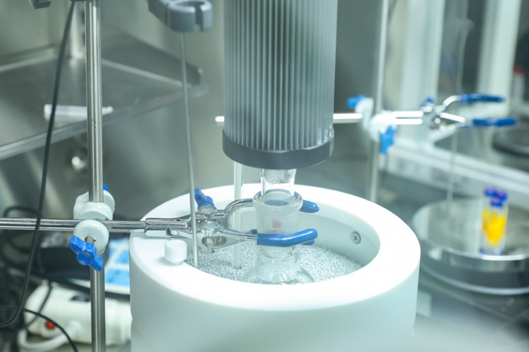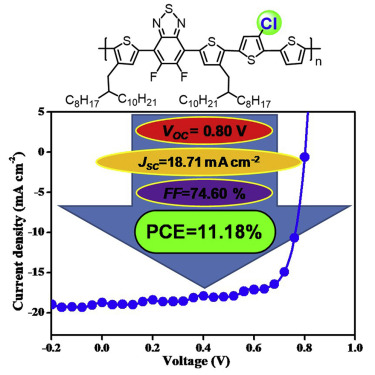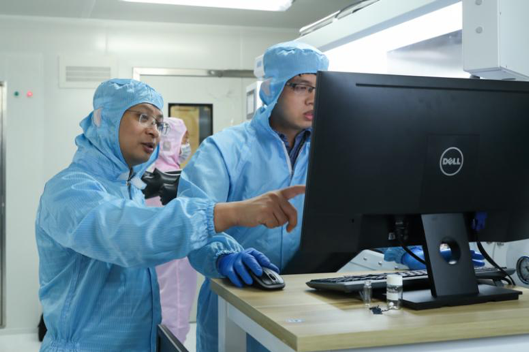Recently, SUSTech Associate Professor He Feng’s research group have made substantial breakthroughs in polymer solar cells. Cell Press’ journal Joule published their academic paper “A Chlorinated π-Conjugated Polymer Donor for Efficient Organic Solar Cells,” whose only corresponding author is He Feng. The first authors Dr. Chen Hui and master student Hu Zhiming are from He Feng’s research group at SUSTech, which is the primary unit involved in the research. Professor He Feng’ s research group has been focusing on the design and synthesis of organic conjugated polymers for optoelectronics, and published articles in top journals such as Joule, Nature Communications, ACS Energy Letters, Chemistry of Materials, and Macromolecules (two of which are cover articles).

Polymer solar cells (PSCs) are based on a blend of a semiconducting conjugated polymer donor, and an electron acceptor have attracted enormous attention as solution-processable, lightweight, flexible, and inexpensive energy sources. With the development of material engineering, interface modification, and advanced device processing in past decades, the power conversion efficiency (PCE) of the state-of-the-art PSCs has already exceeded 14%. Among the many efficient donor polymers, the D-A conjugated polymers with fluorinated benzothiadiazoles (FBTs) have been extensively investigated and demonstrate great potential as superior polymer donor materials. Fluorination has been successfully used in multifarious organic semiconductors, including polymers and small molecules, in the past decade.

However, Professor He Feng’s group found that chlorine is another electronegative halogen with much easier chemical synthesis and a lower raw-material cost. The performances of chlorinated polymer-based PSCs have been beyond those of fluorinated materials in some special polymer systems. In their study, a chlorinated FBT-based polymer was designed and synthesized by incorporating a chlorine atom at the 4 position of the middle thiophene unit. The chemical structure of this compound, named PBT4T-Cl, is shown in Scheme 1. As a polymer donor, inverted fullerene (6,6-phenyl C71 butyric acid methyl-ester [PC71BM]) PSCs with 2% 1,8-diiodooctane (DIO) additive showed a high PCE of 11.18% with an elevated open-circuit voltage of 0.80V, which is the highest efficiency reported to date of a chlorinated polymer-based fullerene PSC and is also one of the highest PCEs among the reported FBT-based PSCs.


More importantly, the PBT4T-Cl-based devices showed superior stability compared with the non-chlorine analog. PBT4TCl-based devices showed almost no change of VOC during 50 days of testing; the PCE of PBT4T-Cl remained at approximately 8.16% after the 50 days of storage. Collectively, the above results indicate that chlorination is a promising route to reduce the material cost with simple and enlargeable synthesis. Through this research, the chlorination of low-bandgap polymers provides new insight into designing p-conjugated polymer semiconductors and realizing further enhancement of polymer solar cell efficiency as well as stability. Therefore, chlorination of the polymer donor is a feasible strategy to simultaneously increase the performance and stability of PSCs, eventually promoting the commercialization of PSCs.

To know more about the backstory of this research project, Professor He Feng was interviewed on campus recently and answered a few questions:
Q: What is the most unforgettable thing for you during the research experience?
A: In the past three years, our group never gave up on the chlorination of the polymer donor despite it being a non-mainstream approach. The discouraging sentiments surrounding us almost stopped us from discovering the findings, but we’re glad that we chose to believe in ourselves. I guess sometimes; adversity is where you should put in more work because it can lead to brand new discoveries that may change the academia or the ordinary people’s life.
Q: Shenzhen is located in the very south of China’s humid subtropical climate region, resulting in 6 to 8 months’ of heat and humidity in summer. What kind of challenges and opportunities does such a climate bring to your research?
A: The advantage of Shenzhen’s climate is the abundance of solar energy. In the summer, there are always hot sunny days with the very high level of UV index. In fall and winter, the precipitation drops significantly and leaves room for many fine days. The gloomy spring is quite short, and this year’s spring was unseasonably sunny. So in general Shenzhen is a good place to develop solar energy. Having said that, the extremely high level of humidity in spring and summer poses a great challenge to many chemical reactions in our experiments – they tend to fail when the environment is too wet. As a result, we chose to do these experiments in a glove box, which can simulate the ideal environment for certain chemical reactions.
Q: What is the prospect of the commercialization of polymer solar cells (PSC) in China?
A: Because new energy is a popular concert right now, there is a large market for PSC both in China and across the globe. However, the commercialization process is still affected by the power conversion efficiency and device stability of current PSCs. At this stage, our research cannot solve all problems in the PSC’s commercialization – we still have a lot to do. I hope our group can team up with other peers in the academia and come up with more innovative and effective designs of high-performance materials and device structures. Our ultimate goal is to make PSC as popular as regular batteries.
Acknowledgments:
Professor Chen Wei from the U.S. Argonne National Laboratory provided assistance to the GIWAXS experiment in this research project. The project received funding from SUSTech, Shenzhen Science and Technology Innovation Commission, Guangdong Natural Science Foundation and the National Natural Science Foundation of China.
Academic Paper Link: https://www.cell.com/joule/fulltext/S2542-4351(18)30229-0
Proofread ByChris Edwards
Photo ByDepartment of Chemistry